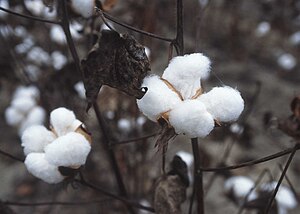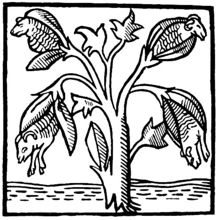Пахта: Тафовут байни таҳрирҳо
х clean up using AWB |
Ҷамшед Ғафуров (баҳс | ҳисса) Барчасбҳо: вироиш тавассути телефони ҳамроҳ вироиш аз барномаи мобилӣ Android app edit |
||
| Сатри 1: | Сатри 1: | ||
[[Акс:Feld mit reifer Baumwolle.jpeg|thumb|300px|left| |
[[Акс:Feld mit reifer Baumwolle.jpeg|thumb|300px|left|Ниҳолҳои пахта ]] |
||
[[Акс:CottonPlant.JPG|thumb|300px|Пахтаи тайёр барои ғунучин. Photo courtesy of USDA Natural Resources Conservation Service.]] |
[[Акс:CottonPlant.JPG|thumb|300px|Пахтаи тайёр барои ғунучин. Photo courtesy of USDA Natural Resources Conservation Service.]] |
||
Нусха 15:08, 21 октябри 2020


Пахта маҳсулоте ки ҳамчун растани меруяд (Gossypium spp.), муқими дар маҳаллаҳои тропикӣ ва субтропикӣ ҳарду дар Ҷаҳони Нав ва дар Ҷаҳони Кӯҳна. Ин маҳсулотро ғалтак мекунанд ва ба материали хеле мулоим ва нарм табдил медиҳанд текстил, ки бештар барои сару либос дар ҳоли ҳозир истифода бурда мешавад. Номи Англисии "пахта" аз калимаи Арабии al qutun, гирифта шудааст.


Култивасия
Successful cultivation of cotton requires a long growing season, plenty of sunshine and water during the period of growth, and dry weather for harvest. In general, these conditions are met within tropical and warm subtropical latitudes in the Northern and Southern hemispheres. Production of the crop for a given year usually starts soon after harvesting the preceding autumn. Planting time in spring varies from the beginning of February to the beginning of June.
Растании Пахта
e
Cotton fiber originates from the cotton plant, an important crop in tropical climates and warm temperate climates. Commercial species of cotton plant are Gossypium hirsutum (U.S.A. and Australia), G. arboreum, G. herbaceum (Asia), and G. barbadense (Egypt).
Таьрих

Cotton has been used to make very fine lightweight либос in areas with tropical climates for millennia. Some authorities claim that it was likely that the Мисрians had cotton as early as 12,000 BC, and evidence has been found of cotton in Мексикои caves (cotton cloth and fragments of bloody fibre interwoven with парs and пар) which dated back to approximately 7,000 years ago. There is clear archaeological evidence that people in South America and India domesticated different species of cotton independently thousands of years ago.
The earliest reference to cotton is in Ҳиндустон. Cotton has been grown in India/Pakistan for more than 6,000 years since the pre-Harappan period, and it is later referred to in the Rig-Veda, composed in 3000 BC. Two thousand years later, the famous Greek historian Herodotus wrote about Indian cotton: "There are trees which grow wild there, the fruit of which is a wool exceeding in beauty and goodness that of sheep. The Indians make their clothes of this tree wool". (Book iii. 106)
In Перу, cotton was the backbone of the development of coastal cultures such as the Moche and Nazca. Cotton was grown upriver, made into nets and traded with fishing villages along the coast for large supplies of fish. The Spanish who came to Mexico in the early 1500s found the peoples there wearing cotton clothing and growing it.
During the late mediaeval period, cotton became known as an imported fibre in northern Europe, without any knowledge of what it came from other than that it was a plant; people in the region, familiar only with animal fibres (wool from sheep), could only imagine that cotton must be produced by plant-borne sheep. John Mandeville, writing in 1350, stated as fact the now-preposterous belief: "There grew there India a wonderful tree which bore tiny lambs on the endes of its branches. These branches were so pliable that they bent down to allow the lambs to feed when they are hungrie.". This aspect is retained in the name for cotton in many European languages, such as German Baumwolle, which translates as "tree wool".
By the end of the 16th century AD, cotton was cultivated throughout the warmer regions in Africa, Евразия and the Америка.

The Indian cotton processing industry was eclipsed during the British colonial rule, as part of the British mercantile policy of deliberate and systematic de-industrialization of India, which forced the closing of Indian factories and processing facilities. The intent of this British policy was to ensure that colonized lands supplied raw materials and that Britain should retain a monopoly on manufacturing. In addition, the invention of the spinning jenny (1764) and Arkwright's spinning frame (1769) enabled cheap mass-production of cotton cloth in the UK. Production capacity was further improved by the invention of the cotton gin by Eli Whitney in 1793. As a result of these policies and developments, British traders developed a commercial chain in which raw cotton fibres were sourced initially from their colonies, processed into cotton cloth in the mills of Lancashire, and then re-exported back on British ships to their captive colonial markets in West Africa, India, and China (via colonized Shanghai and Hong Kong). Later, when the superiority of the American varieties of cotton was established, owing primarily to the length of the fibers, the British started purchasing cotton from slave plantations in the United States and the Caribbean. Due to the enormous quantities of raw cotton required to make cheap bulk exports, British industrialists quickly abandoned expensive raw cotton produced in India in favour of mass-produced cotton from the southern United States, which was much cheaper as it was produced by unpaid slaves. By the mid nineteenth century, "King Cotton" had become the backbone of the southern American economy, and today, roughly 90% of the world's cotton crop is of the long-staple American variety.
In the United States, growing the three crops, cotton, indigo and тамоку, historically was the leading occupation of ғӯломон. After emancipation, the share cropping system evolved, which in many cases differed little from the systems of slavery. During the American Civil War, American cotton exports slumped due to a Union blockade on Southern ports, prompting the main purchasers of cotton, Britain and France, to turn to Egyptian cotton. British and French traders invested heavily in Egyptian cotton plantations and the Egyptian government of Viceroy Isma'il took out substantial loans from European bankers and stock exchanges. After the American Civil War ended in 1865, British and French traders abandoned Egyptian cotton in favour of cheap exports from the United States, sending Egypt into a deficit spiral that led to the country declaring bankruptcy in 1876.
